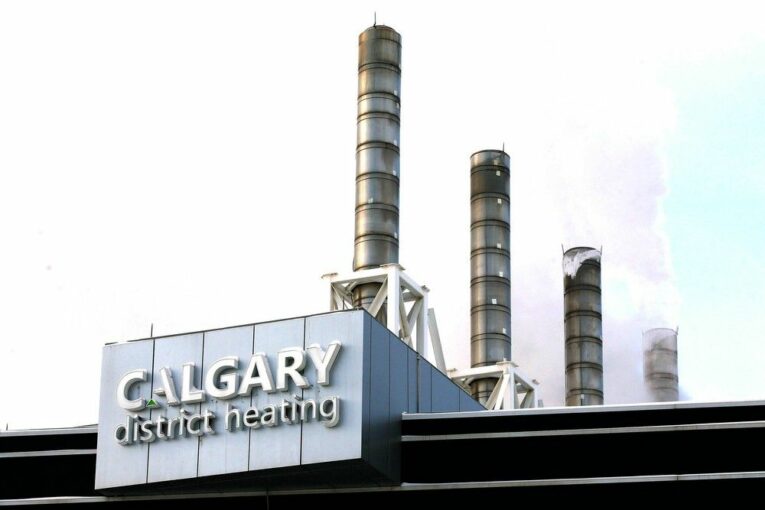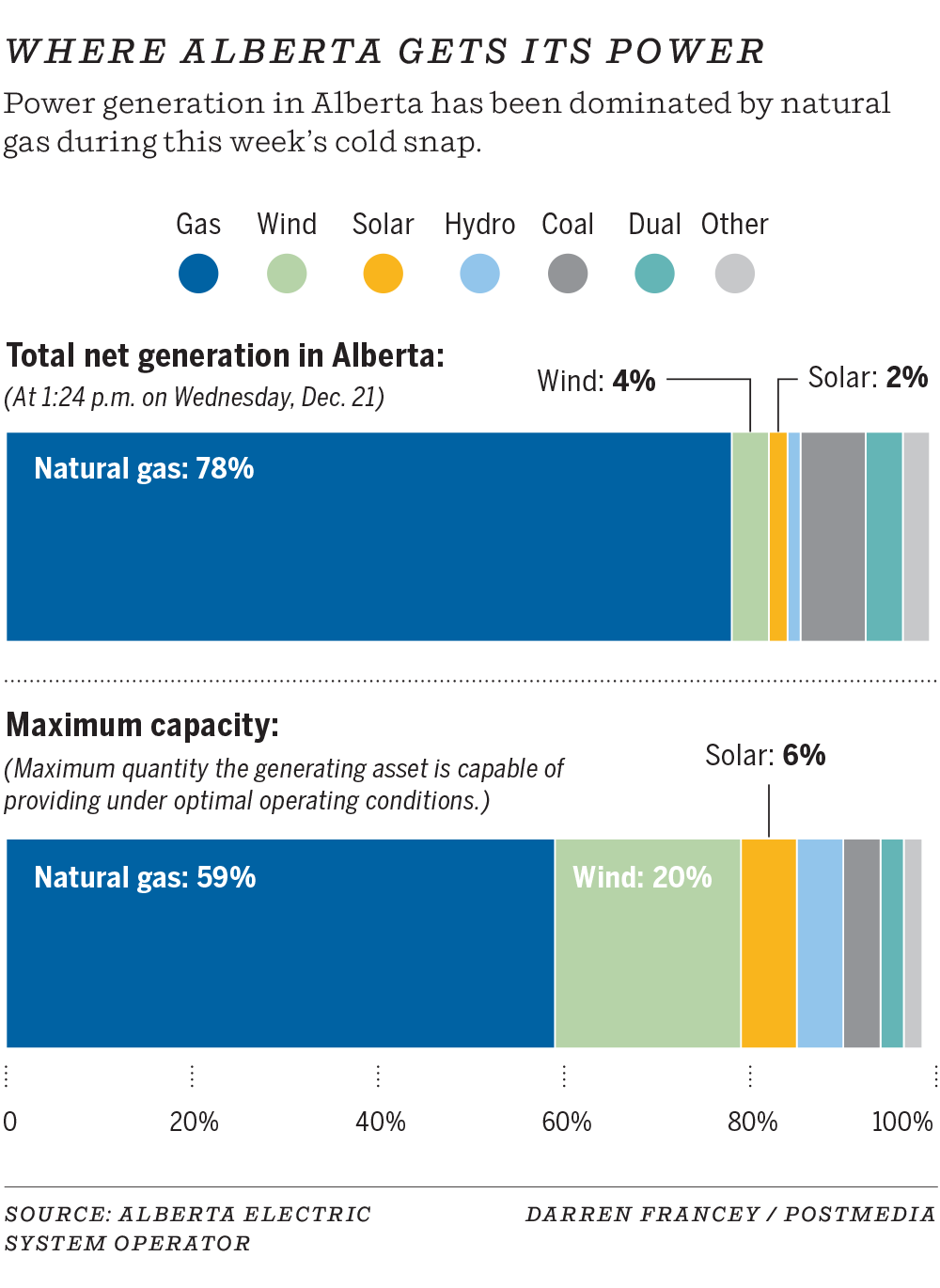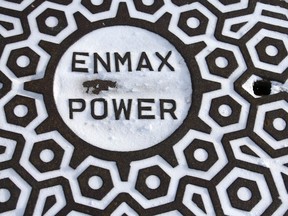
Renewable energy and battery storage could take over the world — the world of electricity — one day.
This, however, is not the day.
Instead, the wicked cold snap gripping Alberta and much of Western Canada underscores the importance of natural gas to keep homes warm and lights on.
Looking at the mix of what’s generating electricity in the province this week, one can plainly see the critical role for gas.
“There’s very little wind and solar is limited during the day and, obviously, none at night. It demonstrates renewables create significant levels of energy when nature is working with you, but it isn’t dispatchable — it is not reliable,” Capital Power CEO Brian Vaasjo said Wednesday.
“In Alberta, there’s really nothing that can take the place of natural gas in the short term, or even the medium term.”
The provincial power grid has been mightily tested in recent days by the prolonged deep freeze.
On Monday, the province set a record for electricity demand at 12,187 megawatts (MW), and promptly set a new hourly peak of 12,193 MW on Wednesday night, according to the Alberta Electric System Operator (AESO).
Prices hit a maximum $999 per megawatt-hour (MWh) on Wednesday morning as a grid alert was issued by the AESO, which was lifted shortly after noon. It happened after one of the larger gas-fired generating units was off-line for several hours.
Recommended from Editorial
-

Power grid recovers after second alert in two days due to extreme cold
-

Shelter doors removed at Chinook station to discourage homeless from gathering
“We’re already in tight supply, and demand is extremely high. That’s a facet of this time of year,” Steven Everett, AESO’s manager of market analytics, said Wednesday.
“It’s a little bit of all hands on deck, in terms of generators supplying the system. And, yeah, if there is an outage, things can get tighter fairly quickly.”
Bone-chilling temperatures mired around -30 C, more people living in the province, record oilsands production and increased economic activity have all contributed to greater power consumption.
AESO also issued a grid alert Tuesday at 4:47 p.m., asking people to conserve power as the system was under stress.
At the time, the grid leaned heavily on fossil fuels, including gas and coal, for electricity generation.
Shortly after 6 p.m. on Tuesday, a supply and demand snapshot on AESO’s website showed just how integral natural gas generation was in the overall mix.
Net generation in the province stood at 11,322 MW, while nearly 700 MW was being imported into the province from Montana, Saskatchewan and British Columbia.
Within Alberta, natural gas was responsible for providing more than 9,300 MW, or 82 per cent of total net generation. Coal was second on the list of fuel types, providing seven per cent.
Dual-fuel generation units, such as plants that can switch between coal and gas, were responsible for about four per cent of generation, followed by hydro.

Given the time of night, solar wasn’t providing any power, nor was any coming from energy storage.
And wind wasn’t blowing strongly, generating about 100 MW, or less than one per cent, at that moment.
By mid-day Wednesday, the mix hadn’t really changed much: gas contributed 78 per cent to total net generation, with wind at four per cent and solar at two per cent.
“We are getting our power from gas and a little bit from coal to get us through this,” said Everett.
“We are, through some of these tighter times, seeing some solar and some wind, so it’s not exclusively from fossil fuels.”
None of this is to say renewables aren’t important or won’t play a much larger role in Alberta’s future.
The sheer amount of private-sector investment flowing into solar and wind projects in this province — more than $4.3 billion of developments announced since 2019 — is a testament to the business case of renewables and their competitive prices.
Climate concerns and government policies to reduce emissions are adding more momentum, including the federal government’s push for a net-zero emitting electricity system by 2035.
Blake Shaffer, an economist at the University of Calgary, said the past week serves as a reminder that solar and wind can provide cheap raw energy, but little effective load-carrying capacity.
“Many people will take this away saying, ‘OK, solar and wind are of no value.’ That’s not the right way to take it. It’s an important reminder that they aren’t capacity resources. They provide value for energy,” he said.
“It’s a big reminder that for capacity resources, this is where Alberta has the big challenge as it decarbonizes.”
Unlike B.C. and Manitoba, which have ample hydro resources, Alberta’s on-demand capacity today comes largely from fossil fuels.
Binnu Jeyakumar, director of electricity at the Pembina Institute, said this week’s events also show more investment will be required to meet growing electricity demand in the future.
Alberta will need a diverse grid, which should include more storage projects and interconnections to other provinces, she said.
“Every generation has its own disadvantages and advantages,” Jeyakumar said.
“People always question, ‘Are renewables reliable?’ We’re seeing evidence here of what happens in traditional thermal generation when you have unplanned outages,” she said of the gas-fired plant going off-line.

The broader question is how Alberta’s power system will transition into the future.
It could mean natural gas plants are combined with carbon capture, utilization and storage (CCUS) technology to reach net-zero emissions. It will mean more battery storage and renewables.
Capital Power, which has natural gas, wind and solar facilities in Alberta, is working on a proposed CCUS development near its Genesee Generating Station west of Edmonton.
Vaasjo still expects to see a significant amount of gas used for power generation in Alberta in 2035.
The transition, however, won’t happen overnight.
And on another bitterly cold December day, gas is shouldering the biggest load.
“It’s a day that people should remember,” said Vaasjo.
“What’s going to keep my lights on, on days like today . . . that’s where more and more people are realizing there’s a role for natural gas as we move forward.”
Chris Varcoe is a Calgary Herald columnist.
You can read more of the news on source
